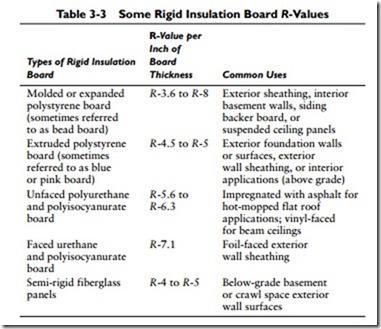Air Barriers and Air/Vapor Retarders
Air barriers are used to block random air movement through structural cavities while at the same time allowing the moisture in the air to diffuse back out. Some common materials used as air barriers are fibrous spun polyolefin (commonly called house wrap), gypsum drywall board, plywood, and foam board. Air barriers are installed to the outside of the structure, with all joints sealed with tape.
Caution
House wrap materials react poorly with the wood lignin in certain types of exterior wood sidings, such as cedar, red- wood, and manufactured hardboard siding. Substitute 30-lb impregnated paper for the house wrap in these applications. It will not react to the wood lignin.
Air/vapor retarders are materials designed to control simultaneously both air movement and water vapor transmission. Air/vapor retarders are very common in regions with hot, humid weather, such as that common in the southern United States. An air/vapor retarder can be a single material, but it is more commonly a combination of polyurethane plastic sheets, builder’s aluminum foamboard insulation, and other exterior sheathings. Like the house wrap, it is applied to the exterior of the structure, with all joints carefully sealed.
Insulating Materials
Insulating materials are specifically designed to reduce the rate of heat transmission through ordinary construction materials to an acceptable level. A dry material of low density is considered a good insulator; however, in addition to this characteristic, it must also have a conductivity value of less than 0.5.
As described earlier, the conductivity value of a material is a purely arbitrary one determined by the amount of heat that flows in 1 hour through a 1-inch thickness of a material 1 square foot in area with the temperature exactly 1 degree Fahrenheit higher on one side of the material than on the other.
Air spaces, or air spaces bounded by either ordinary building materials or aluminum foil, also provide some insulation, but not to the degree formerly thought possible. Dead air spaces in building walls were once considered capable of preventing heat transmission in a manner similar to the space between the walls of a Thermos bottle. Later research proved this to be a somewhat false analogy, because the air in such spaces often circulates and transmits heat by convection.
Air circulation can be checked by filling the hollow space with an insulating material that contains a great number of small, con- fined air spaces per unit volume. This stoppage of air circulation is what produces the insulating effect, and not merely the existence of the air space. Under these circumstances, it is obvious that the most practical method of insulation is to fill the area in the walls with a material containing these minute air spaces.
Several manufacturers produce insulating materials in a variety of shapes and forms for installation in houses and other buildings. Frequently, instructions for the installation of the products will also be provided by the manufacturer. Local building supply outlets and lumber yards will often be very helpful, too, and will usually recommend the best way to install the insulation material. Some of these materials and their applications are described in the following paragraphs.
Rigid Insulation Board
Rigid insulation board (Figure 3-5) is a rigid or semirigid synthetic product commonly referred to as structural insulating boards (SIP)
or panels, rigid boards, foam insulation boards, rigid foam insula- tions, slab insulation, or sheathing boards. They are produced under a wide variety of trade names. Rigid insulation boards or panels are commonly manufactured in 2′ X 4′, 4′ X 4′, and 4′ X 8′ sheet sizes with thicknesses of 1⁄2–, 3⁄4–, and 1– nonlami- nated and laminates of 1⁄2–, 1–, and 2–. All edges are butted. Rigid insulation boards are available faced or unfaced. Reflective facings function as vapor retarders.
Caution
Rigid insulation board is flammable and must be covered with a fire-resistant material, such as gypsum wall board, when it is installed on interior walls.
Some rigid insulation board is produced specifically for use on interior walls. This type is commonly made from wood or cane fibers with one side prefinished. Rigid insulation board designed for use as structural insulation is produced from compressed fibrous materials other than wood and does not have a prefinished surface. Rigid board panels made from polyurethane, polystyrene, polyisocyanurate, and phenolic are commonly used for exterior wall sheathing in new construction and to insulate basement and crawl space walls. Some R-values for common type of rigid insula- tion board are listed in Table 3-3.
Note
Rigid board insulation has a high R-value and can be used in areas where space is limited, but it is also has a higher cost per inch than other insulating materials.
Caution
Rigid insulation board must be installed with tightly butted edges. Fill gaps of 1⁄16 inch or greater with pieces of insulation
board cut to fit. Do not fill a gap between boards with other noninsulatng materials or any type of adhesive.

